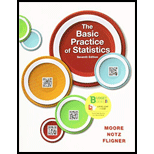
Concept explainers
To find: The variable that is most likely to have a
Answer to Problem 3.15CYS
The correct option is (c) Lengths of 100 newborns in Connecticut.
Explanation of Solution
Reason for correct answer:
The variables are most likely to have a normal distribution if the scores on tests taken by many people have repeated measurements of the same quantity and the characteristics of biological populations.
Here, the lengths of 100 newborns in Connecticut are taken by the characteristics of biological populations. That is, the lengths of newborns are in a particular
Hence, the correct option is (c) Lengths of 100 newborns in Connecticut.
Reason for incorrect answers:
As the age of the person increases, the income decreases. The variable of income per person for 150 different countries is skewed to the right.
Also, the variable sale price of 200 homes in Santa Barbara, California is skewed to the right because there would be few homes with higher prices.
Hence, options (a) and (b) are not correct.
Conclusion:
Thus, the variables of the lengths of 100 newborns in Connecticut are most likely to have a normal distribution.
Introduction:
Normal distribution:
For any continuous random variable x whose graph of distribution is symmetric, peaked and bell shaped is known as normal distribution.
Want to see more full solutions like this?
Chapter 3 Solutions
Loose-leaf Version for The Basic Practice of Statistics 7e & LaunchPad (Twelve Month Access)
 MATLAB: An Introduction with ApplicationsStatisticsISBN:9781119256830Author:Amos GilatPublisher:John Wiley & Sons Inc
MATLAB: An Introduction with ApplicationsStatisticsISBN:9781119256830Author:Amos GilatPublisher:John Wiley & Sons Inc Probability and Statistics for Engineering and th...StatisticsISBN:9781305251809Author:Jay L. DevorePublisher:Cengage Learning
Probability and Statistics for Engineering and th...StatisticsISBN:9781305251809Author:Jay L. DevorePublisher:Cengage Learning Statistics for The Behavioral Sciences (MindTap C...StatisticsISBN:9781305504912Author:Frederick J Gravetter, Larry B. WallnauPublisher:Cengage Learning
Statistics for The Behavioral Sciences (MindTap C...StatisticsISBN:9781305504912Author:Frederick J Gravetter, Larry B. WallnauPublisher:Cengage Learning Elementary Statistics: Picturing the World (7th E...StatisticsISBN:9780134683416Author:Ron Larson, Betsy FarberPublisher:PEARSON
Elementary Statistics: Picturing the World (7th E...StatisticsISBN:9780134683416Author:Ron Larson, Betsy FarberPublisher:PEARSON The Basic Practice of StatisticsStatisticsISBN:9781319042578Author:David S. Moore, William I. Notz, Michael A. FlignerPublisher:W. H. Freeman
The Basic Practice of StatisticsStatisticsISBN:9781319042578Author:David S. Moore, William I. Notz, Michael A. FlignerPublisher:W. H. Freeman Introduction to the Practice of StatisticsStatisticsISBN:9781319013387Author:David S. Moore, George P. McCabe, Bruce A. CraigPublisher:W. H. Freeman
Introduction to the Practice of StatisticsStatisticsISBN:9781319013387Author:David S. Moore, George P. McCabe, Bruce A. CraigPublisher:W. H. Freeman





